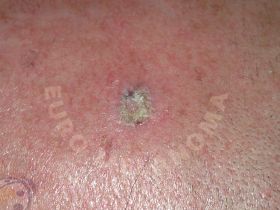Keratoza aktinike
Select another type of skin cancer:
Actinic keratosis AK is a very common type of skin lesion. It is generally pre-cancerous but, if left untreated, can develop into squamous cell carcinomas.
Anyone can develop AK, but it is most common in fair-skinned, middle-aged and elderly people, as well as those who have previously been diagnosed with the condition. Also known as ‘solar keratosis’, it is caused by over-exposure to UV rays from the sun and/or indoor tanning beds.
AK is a chronic condition that often recurs. If someone gets AK lesions, they are more prone to develop new ones and old lesions tend to reappear.
Special risk groups. such as organ transplant recipients (OTR) and other chronically immunosuppressed people, as well as those undergoing regular dialysis, have an increased risk of developing AK.

Appearance
AKs can appear either on their own or in patches. They typically look like small (usually 1-2cm), crusty patches of skin and can be flesh-toned, red, white, pink, or a combination of colours. Some lesions can be very small, or virtually invisible, but can be identified by their rough texture. AK can have a negative impact on quality of life as lesions can cause cosmetic discomfort.
Both visible and non-visible AKs can be a sign of further lesions beneath the skin, any of which could develop into squamous cell carcinomas. Therefore, it is important to seek treatment, regardless of the lesions size or appearance.
Feel
Lesions may feel itchy, sensitive or painful, with some people experiencing a ‘prickly’ or ‘burning’ sensation. For others, there may be no unusual feeling at all.
To the touch, skin may feel dry, scaly or rough with a ‘sandpaper-like’ texture, regardless of whether the lesion is visible or not.
Where can it appear?
AKs can occur anywhere on the body but are most often found in more sun-exposed areas, such as the face, neck, ears, chest, hands, limbs and scalp.
What is the treatment?
Single lesions are often frozen with liquid nitrogen and cases of multiple lesions can be treated locally with medical creams that either; stimulate the local immune response, make the cancerous cells sensitive to light, or contain chemotherapy drugs.
Contact your GP or dermatologist if:
You are unsure about an existing or new patch on your skin and would like to get it checked.
The patch(es) begin to bleed, get bigger, change colour, feel tender or develop into a lump.
You have previously been diagnosed with actinic keratosis, as many patients develop new lesions within one year.
Early treatment of AKs can prevent them from becoming cancerous, so it is important to get any suspicious patches on your skin checked as soon as possible.












